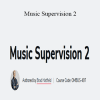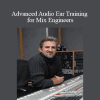Beth Denisch – Counterpoint
$1,250.00 Original price was: $1,250.00.$250.00Current price is: $250.00.
Digital Download: You will receive a download link via your order email after successful payment.
Counterpoint is the technique of writing independent melodic lines that work together to create effective music. This linear perspective has influenced some of the most popular songs and artists in the 20th century
Counterpoint
Counterpoint is the technique of writing independent melodic lines that work together to create effective music. This linear perspective has influenced some of the most popular songs and artists in the 20th century, including the music of the Beatles, Beach Boys, Pink Floyd, David Bowie, and many other contemporary artists—even in the sampling techniques of hip-hop and techno. The study of Counterpoint is essential knowledge for songwriters, composers, and musicians who want to strengthen their compositional skills.
Berklee Online’s Counterpoint course explores the mechanics of basic contrapuntal technique, focusing on the horizontal aspects of composition; in other words, how melodies interact with one another. The course begins with writing a simple melodic line that works with an existing melody. You will then learn to add complexity to your melodic lines using thicker textures and the concepts of consonance and dissonance. You will study motivic manipulations of sequence, inversion, retrograde, and other variations. The course also explores various canonic techniques, including simple, mirror, crab, and mensuration canons.
This course uses musical examples from the Medieval, Renaissance, Baroque, Classical, Romantic, and 20th century periods, in addition to relevant examples from contemporary popular artists and styles. You’ll have access to a timeline from which you can see the chronological and geographical placement of musical examples as you listen to them. Throughout the course, you will strengthen your music listening, reading, and writing skills through hands-on writing activities. The goal of the course is to give you a broad overview of counterpoint and improve your compositional skills, regardless of stylistic preference.
By the end of this course, you will be able to:
- Identify and compose music using various contrapuntal techniques
- Differentiate and apply counterpoint ratios, including 1:1, 2:1, 3:1, 4:1, suspensions, and consonant syncopations
- Identify stylistic uses of consonance and dissonance in diverse style periods
- Manipulate and apply motives, using sequence, inversion, retrograde, and other variations
- Write canons, including simple, accompanied, at intervals other than the octave, crab, and mensuration canons
Syllabus
Lesson 1What Is Counterpoint?
Lesson 2 Ratios, Phrases, and Form
Lesson 3 Non-Chord Tones
Lesson 4 Motivic Manipulation
Lesson 5 Canon
Lesson 6 Writing Two-Part Tonal Counterpoint with Simple Canon
Lesson 7 Accompanied Canon
Lesson 8 Inverted Canon at the 4th and 5th
Lesson 9 Double Counterpoint, Alchemy, and the Crab Canon
Lesson 10 Stretching and Squeezing Time: Prolation and the Mensuration Canon
Lesson 11 Versatility of the Canon
Lesson 12 Introduction to “Adagio for Strings” by Samuel Barber
Requirements
Prerequisites and Course-Specific Requirements
Completion of Music Theory 201, Music Theory and Composition 1, or Getting Inside Harmony 2, or equivalent knowledge and experience is required.
Student should be able to:
- Demonstrate fluent music reading skills including use of treble and bass clefs, intervals, key signatures, time signatures, and chord identification
- Understand simple triadic melody harmonizations
Required Textbook(s)
- Contemporary Counterpoint: Theory & Application by Beth Denisch, Berklee Press
Software Requirements
- MuseScore, Finale 2012 or higher, or Sibelius 4 or higher. Note that assignment templates will be provided as MusicXML files, which you will import into your notation program to complete. The completed homework files should be saved as a .pdf file for submission to the instructor.
General Course Requirements
Below are the minimum requirements to access the course environment and participate in live chats. Please make sure to also check the Prerequisites and Course-Specific Requirements section above, and ensure your computer meets or exceeds the minimum system requirements for all software needed for your course.
Mac Users
- OS X 10.10 Yosemite or higher
PC Users
- Windows 7 or higher
All Users
- Latest version of Google Chrome
- Zoom meeting software (available in the course when joining your first chat)
- Webcam
- Speakers or headphones
- External or internal Microphone
- Broadband Internet connection
Instructors
Author & Instructor
Beth Denisch is a Professor in the Composition department at Berklee College of Music. Her music has been performed throughout the U.S. and in Canada, Mexico, Greece, Ukraine, Russia, China, and Thailand and recorded by Juxtab, Albany, and Interval record labels.
She has received awards and grants from ASCAP, Meet the Composer, PatsyLu Fund, American Composers Forum, and American Music Center. Her music has been commissioned by the Handel and Haydn Society, St. Louis Historical Society, Equinox Chamber Players, Philadelphia Classical Symphony, and Chamber Orchestra Kremlin. Denisch is active in the Feminist Theory and Music, Gender Research in Music and Education, and Women’s Philharmonic Advocacy organizations. She holds a bachelor of music degree from North Texas State University and master and doctoral degrees in music from Boston University.
Instructor
Carolina Hengstenberg is a Professor in the Composition undergraduate program at Centro Superior Musica Creativa Conservatory in Madrid, Spain. She studied alto saxophone and classical music at Katarina Gurská Conservatory in Spain; jazz, contemporary writing and arranging at Musica Creativa; and earned a degree in Composition at Berklee College of Music, where she also studied Film Scoring and Conducting. Since then, she continued further studies in Orchestral Conducting in USA, Spain and Portugal.
She cofounded an independent animation and music studio Bubblegum Cartoons, worked as a musical theater director, and was also one of the orchestrators for the Christmas Concert at the Carnegie Hall in New York. She is currently working as a film composer, orchestrator, arranger and conductor.
Carolina is a brilliant and sophisticated composer, who combines of Jazz, Classical, Contemporary and Flamenco groove oriented music. Additionally, Carolina is a board member at the International Alliance for Women in Music, and CIMA in Spain, to promote the work and music of female musicians from all over the world.
What’s Next?
When taken for credit, Counterpoint can be applied towards these associated programs:
Associated Certificate Programs
- General Music Studies Professional Certificate
- General Music Studies Advanced Professional Certificate
Associated Degree Majors
- Bachelor’s Degree in Music Production
- Bachelor’s Degree in Music Business
- Bachelor’s Degree in Music Composition for Film, TV, and Games
- Bachelor’s Degree in Electronic Music Production and Sound Design
- Bachelor’s Degree in Interdisciplinary Music Studies (Create Your Own Major)
- Bachelor’s Degree in Songwriting
- Bachelor’s Degree in Songwriting and Producing Music
Get Download Beth Denisch – Counterpoint at IMC.sale today!
Delivery Method
– After your purchase, you’ll see a View your orders link which goes to the Downloads page. Here, you can download all the files associated with your order.
– Downloads are available once your payment is confirmed, we’ll also send you a download notification email separate from any transaction notification emails you receive from IMC.sale.
– Since it is a digital copy, our suggestion is to download and save it to your hard drive. In case the link is broken for any reason, please contact us and we will resend the new download link.
– If you cannot find the download link, please don’t worry about that. We will update and notify you as soon as possible at 8:00 AM – 8:00 PM (UTC+8).
Thank You For Shopping With Us!





9 reviews for Beth Denisch – Counterpoint
There are no reviews yet.